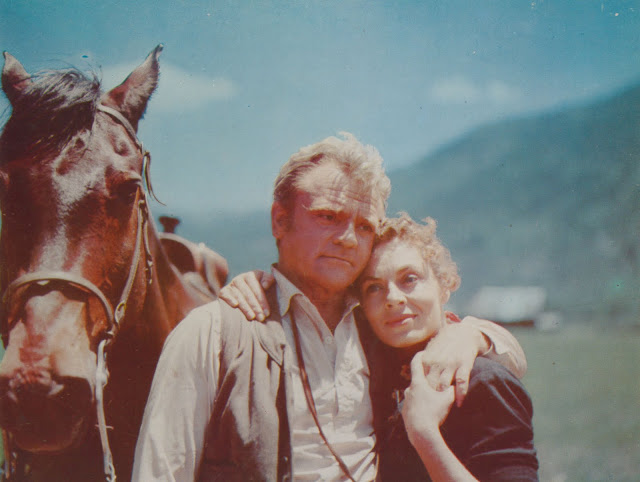The Neglected Run For Cover
A lot of films are good enough to get by despite lackluster presentation. Run For Cover is one that cannot. It's a minor 50's Western needing all the visual help it can get. What we've had since this one left theatres is a big-screen essential reduced to home-viewed mediocrity. As with so many features made during that decade, Run For Cover was customized for size and scenics. Take these away and you lose the best reasons for seeing it. Run For Cover plays on Netflix and Dish Network's On-Demand. The latter is free to subscribers. Both services are hosts to a transfer
William Pine and William Thomas were industry-known as the "Dollar Bills." They'd been 14 years producing low-budget actioners for
Cagney got along with Ray, this not always a given, as the actor regarded many if not most of his directors as functioning dimwits. JC was also proactive in matters of scripting and would go to writers with whatever suggestions he thought might enhance a finished product. He and Nicholas Ray were congenial enough to devise what Cagney later referred to as offbeat touches to differentiate their Western from conventional ones mass-generated by an increasingly genre-focused industry. Cagney liked the idea of using natural locations, in this case Durango , Colorado Colorado outdoors, with the remaining seventy percent lensed back at Paramount Durango
 |
| Jim and Mrs. Cagney Pal It Up With An Exhibitor Host During the Star's Run For Cover Promotional Tour. |
Run For Cover finished that summer of 1954, but would linger on Paramount shelves awaiting the release of White Christmas and 1955's rollout of completed Vistavision features. RFC's premiere took place in Austin, Texas on April 4, 1955, to which James Cagney contributed several days public appearing (the first time in ten years he's been out to meet the people, said Variety). The star was in evidence over continued weeks promoting the film, indication of a percentage participation, if not satisfaction with a western he in fact found disappointing. Cagney had attended a projection room Run For Cover screening in February, accompanied by his two children, who, according to Army Archerd, had always wanted to see their father in a western. Cagney ducked chaps and spurs since the near self-parody of The Oklahoma Kid in 1939. It wasn't typical of him to attend screenings of a finished work. According to Archerd, Cagney disclosed that of the fifty pix in which he's appeared, Cover was but the fifth he'd seen. The star was not long realizing that nearly all those offbeat touches he and director Ray cooked up were now missing from Run For Cover. Still smarting twenty-five years later when he reviewed a long career with biographer John McCabe, Cagney used explicit language to characterize studio executives who'd once again ruined a project to which he and others seriously applied themselves.
 |
| Nicholas Ray's Credit Goes Front and Prominent on this French Poster. |
Run For Cover's negative cost of $1.2 million was coincidentally matched by domestic rentals in the same amount. In fact, RFC would be one of the lower grossing Paramounts of that year. Was it Cagney or westerns the public was tiring of? Nicholas Ray later said the film deflated because there'd not been enough time to prepare and see it through properly. Like others of the Pine-Thomas group, Run For Cover's negative reverted to the producers and was theirs to re-title and reissue in 1961 as Colorado Paramount Paramount






